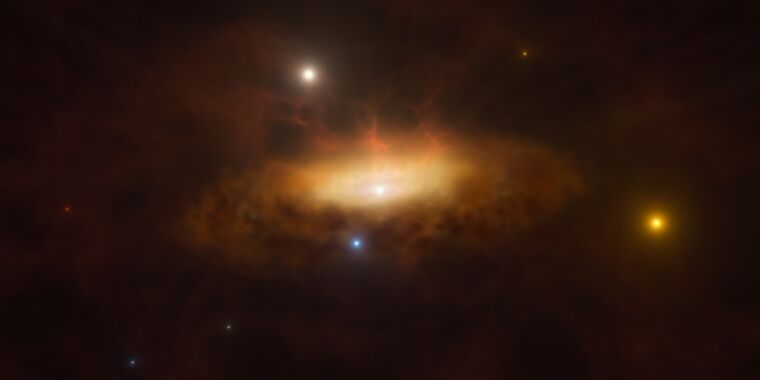Supermassive black hole roars to life as astronomers watch in real time

Artist’s animation of the black hole at the center of SDSS1335+0728 awakening in real time—a first for astronomers.
In December 2019, astronomers were surprised to observe a long-quiet galaxy, 300 million light-years away, suddenly come alive, emitting ultraviolet, optical, and infrared light into space. Far from quieting down again, by February of this year, the galaxy had begun emitting X-ray light; it is becoming more active. Astronomers think it is most likely an active galactic nucleus (AGN), which gets its energy from supermassive black holes at the galaxy’s center and/or from the black hole’s spin. That’s the conclusion of a new paper accepted for publication in the journal Astronomy and Astrophysics, although the authors acknowledge the possibility that it might also be some kind of rare tidal disruption event (TDE).
The brightening of SDSS1335_0728 in the constellation Virgo, after decades of quietude, was first detected by the Zwicky Transient Facility telescope. Its supermassive black hole is estimated to be about 1 million solar masses. To get a better understanding of what might be going on, the authors combed through archival data and combined that with data from new observations from various instruments, including the X-shooter, part of the Very Large Telescope (VLT) in Chile’s Atacama Desert.
There are many reasons why a normally quiet galaxy might suddenly brighten, including supernovae or a TDE, in which part of the shredded star’s original mass is ejected violently outward. This, in turn, can form an accretion disk around the black hole that emits powerful X-rays and visible light. But these events don’t last nearly five years—usually not more than a few hundred days.
So the authors concluded that the galaxy has awakened and now has an AGN. First discovered by Carl Seyfert in 1943, the glow is the result of the cold dust and gas surrounding the black hole, which can form orbiting accretion disks. Gravitational forces compress the matter in the disk and heat it to millions of degrees Kelvin, producing radiation across the electromagnetic spectrum.
Alternatively, the activity might be due to an especially long and faint TDE—the longest and faintest yet detected, if so. Or it could be an entirely new phenomenon altogether. So SDSS1335+0728 is a galaxy to watch. Astronomers are already preparing for follow-up observations with the VLT’s Multi Unit Spectroscopic Explorer (MUSE) and Extremely Large Telescope, among others, and perhaps even the Vera Rubin Observatory slated to come online next summer. Its Large Synoptic Survey Telescope (LSST) will be capable of imaging the entire southern sky continuously, potentially capturing even more galaxy awakenings.
“Regardless of the nature of the variations, [this galaxy] provides valuable information on how black holes grow and evolve,” said co-author Paula Sánchez Sáez, an astronomer at the European Southern Observatory in Germany. “We expect that instruments like [these] will be key in understanding [why the galaxy is brightening].”
There is also a supermassive black hole at the center of our Milky Way galaxy (Sgr A*), but there is not yet enough material that has accreted for astronomers to pick up any emitted radiation, even in the infrared. So, its galactic nucleus is deemed inactive. It may have been active in the past, and it’s possible that it will reawaken again in a few million (or even billion) years when the Milky Way merges with the Andromeda Galaxy and their respective supermassive black holes combine. Only much time will tell.
Astronomy and Astrophysics, 2024. DOI: 10.1051/0004-6361/202347957 (About DOIs).
Listing image by ESO/M. Kornmesser
Source link
